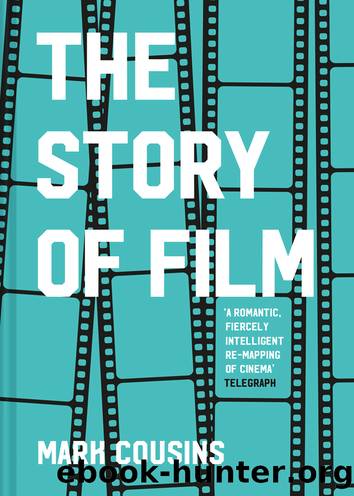The Story of Film by Cousins Mark;

Author:Cousins, Mark;
Language: eng
Format: epub
Publisher: Pavilion Books
213
A master director at the height of his powers during a great decade for Italian cinema: Federico Felliniâs acclaimed account of creative indecision and mid-life crisis, 8½. Italy, 1963.
214
Although the film was shot in widescreen, this frame grab still reveals how Antonioni and his cinematographer Gianni di Venanzo framed their actors (here Jeanne Moreau) unconventionally in La Notte. Italy, 1961.
81â2âs storyline dipped in and out of Mastroianniâs characterâs inner life but our final Italian director of the period rejected storytelling more radically than Fellini or any of his fellow countrymen. Michelangelo Antonioni started working in cinema by making documentaries, directed somewhat conventional features in the 1950s, became interested in the American abstract painting of the end of that decade and, in 1960, began a trilogy of films which are often thought of as the most modern of their time. LâAvventura (Italy, 1960), La notte/The Night (Italy, 1961) and Lâéclisse/Eclipse (Italy, 1962) each try to express the anxiety of the modern age, as Fellini had latterly done, but use emptiness rather than fantasy as their central idea. This image from La notte helps explain (214). Jeanne Moreau plays the rich wife of a writer â Mastroianni again. They go to a party together, meet other people and, at dawn, she says to him, âI feel like dying because I no longer love you.â
This is just a starting point, however. Where Pasolini photographed people square on and mostly in close-up, Antonioniâs characters are often to the side of the frame or small in it, or half hidden. When they walk out of it entirely, the shot holds and we gaze at nothing, a concrete wall, the corner of a street, dying light in the sky. When he directs Moreau â the muse of the French filmmakers â he is very specific, treating her like a chess piece on a board. Her characterâs feelings, her psychology, are not the centre of the film as were Brandoâs or Steigerâs in America, for example. Space and dead time are as important. The imagery does not express what she feels but what the director feels about her isolation. As if to emphasize this point, the camera often films from way above eye level, looking down on the characters who wander through their lives like figures from Baudelaire. LâAvventura, La notte, and lâéclisse place their protagonists in a built landscape as Alain Resnais had done in LâAnnée dernière à Marienbad, made at the same time (France, 1961). But where Resnais was interested in the ambiguities of memory and time, Antonioni looks at the despair and meaninglessness of modern life with the eye of an architect. He takes the themes of dramatist Ibsen and films them with the uncluttered rigour of the buildings of Le Corbusier. Just a year or so after Godardâs breakthrough, Antonioni reduced the action in his films â what the characters do â to just one of many other spatial and temporal elements. His long, slow, semi-abstract shots paved the way for three great
Download
This site does not store any files on its server. We only index and link to content provided by other sites. Please contact the content providers to delete copyright contents if any and email us, we'll remove relevant links or contents immediately.
The Kite Runner by Khaled Hosseini(5016)
Gerald's Game by Stephen King(4487)
Dialogue by Robert McKee(4244)
The Perils of Being Moderately Famous by Soha Ali Khan(4107)
The 101 Dalmatians by Dodie Smith(3397)
Story: Substance, Structure, Style and the Principles of Screenwriting by Robert McKee(3351)
The Pixar Touch by David A. Price(3306)
Confessions of a Video Vixen by Karrine Steffans(3162)
How Music Works by David Byrne(3032)
Harry Potter 4 - Harry Potter and The Goblet of Fire by J.K.Rowling(2896)
Fantastic Beasts: The Crimes of Grindelwald by J. K. Rowling(2889)
Slugfest by Reed Tucker(2866)
The Mental Game of Writing: How to Overcome Obstacles, Stay Creative and Productive, and Free Your Mind for Success by James Scott Bell(2804)
4 - Harry Potter and the Goblet of Fire by J.K. Rowling(2591)
Screenplay: The Foundations of Screenwriting by Syd Field(2484)
The Complete H. P. Lovecraft Reader by H.P. Lovecraft(2429)
Scandals of Classic Hollywood: Sex, Deviance, and Drama from the Golden Age of American Cinema by Anne Helen Petersen(2420)
Wildflower by Drew Barrymore(2406)
Casting Might-Have-Beens: A Film by Film Directory of Actors Considered for Roles Given to Others by Mell Eila(2315)
